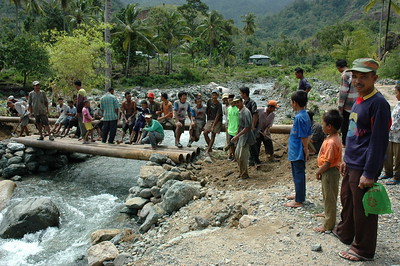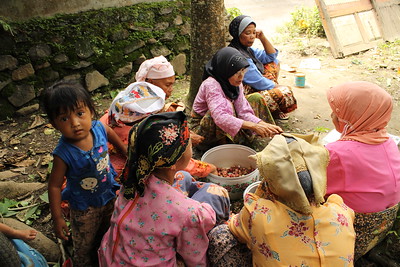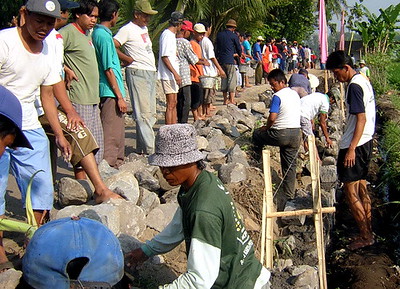Kapanlagi.com - Indonesia is known as a nation rich in traditions and culture. One unique culture in Indonesia is mutual cooperation (gotong royong). Mutual cooperation has become a distinctive characteristic. Throughout generations, mutual cooperation culture is still preserved until now. However, there are still many people who do not understand the true meaning of mutual cooperation.
By the general public, mutual cooperation is also often referred to as community work. It is not just a culture, but mutual cooperation has become part of the identity of the community, especially in rural areas. The concept of mutual cooperation not only makes work feel lighter and faster to complete, but it can also strengthen relationships among community members and maintain unity.
To better understand the meaning of mutual cooperation and the importance of preserving this culture, let's take a look at the following summary compiled from various sources.
1. Understanding Gotong Royong

Gotong royong is (credit: flickr)
Understanding gotong royong should be understood by every member of society. This is because gotong royong is an important aspect that plays a role in building harmonious and peaceful relationships. In the Indonesian Dictionary (KBBI), gotong royong is defined as activities or work that is done together, with the principle of mutual assistance or helping each other.
In addition, some experts emphasize that the understanding of gotong royong is closely related to cooperation. Here are some definitions of gotong royong according to experts who emphasize the element of cooperation.
1. Koentjaraningrat refers to gotong royong as a concept that is closely related to the lives of agricultural communities or agrarian societies. Gotong royong becomes a system of additional labor direction from outside the family to fill in the gaps, so that farming activities can run optimally.
2. Sakjoyo and Pujiwati Sakjoyo argue that gotong royong is a custom of mutual assistance in society that is evident in social activities, both based on kinship relationships and carried out based on efficiency and practicality.
3. Mubyarto states that gotong royong is an activity carried out together to achieve common goals.
2. The Purpose of Gotong Royong
The definition of gotong royong is an activity that is done together, making heavy work feel lighter. However, it turns out that lightening the workload is not the main goal of gotong royong. This positive activity that has become a culture has several purposes. The purposes of gotong royong are as follows.
1. Making heavy work feel lighter and finishing quickly.
2. Saving time, energy, and expenses.
3. Strengthening the sense of unity among members of the community.
4. Strengthening the bond of brotherhood among fellow members, because with gotong royong, the activity can become a gathering to build closeness.
5. Encouraging the participation of every member of the community to contribute and work together in solving a problem together.
3. Values in Gotong Royong

Illustration depicting gotong royong (credit: flickr)
As a habit that has become a culture, mutual cooperation has been passed down from generation to generation. It is not without reason why mutual cooperation is considered as a valuable culture and habit. Because in mutual cooperation, there are values that are useful for communal life. Here are some values in the understanding of mutual cooperation.
1. Unity Value
The implementation of mutual cooperation will bring members of the community closer and foster a sense of togetherness. Through mutual cooperation, community members will realize that they need each other. This indirectly helps to maintain unity and solidarity.
2. Value of Togetherness
The activity of mutual cooperation reflects the warmth of togetherness in the community. The preserved culture of mutual cooperation has unconsciously made the community grow together and solve their problems together.
3. Value of Helping Each Other
Mutual cooperation provides an opportunity for the community to help each other, share burdens, and solve tasks together. This makes the process more efficient and effective. In addition, harmony among the community is also maintained.
4. Social Value
Mutual cooperation can reflect a positive social life of the community. As we know, humans are created as social beings who need and interact with each other. Gotong royong can be one form of positive social interaction.
5. Value of Sacrifice
When participating in gotong royong, a person will also gain the value of sacrifice. This is because, when taking part in gotong royong, a person will sacrifice their time and energy to solve problems together.
4. Benefits of Gotong Royong

Benefits of mutual cooperation (credit: flickr)
Gotong royong is something that must be maintained and preserved. Because, the values in gotong royong should be passed down from generation to generation. In addition, in practice, gotong royong brings benefits to society. Some of the benefits of gotong royong are as follows.
1. Work is completed quickly without having to spend money, and if it is a physical building construction, it will save a lot of budget. Labor costs are reduced with the existence of gotong royong.
2. Brotherhood and togetherness among fellow citizens become closer and the community certainly gets to know each other.
3. Building a sense of solidarity within the community.
4. Environmental security is guaranteed, with a sense of brotherhood and togetherness as well as getting to know each other among the residents, surely if there are new arrivals or suspicious foreign guests, the residents will quickly find out.
5. Residents become more caring and helpful to other residents, so that tranquility and peace are realized.
Those are some explanations about the understanding of gotong royong. Hopefully, it is useful and can broaden your knowledge.
(kpl/psp)
Disclaimer: This translation from Bahasa Indonesia to English has been generated by Artificial Intelligence.















